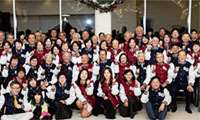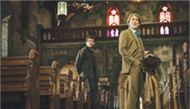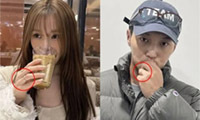Real women don’t wear couture. Lacking the budgets or the bodies for it, they just watch. At best, they dress for short-term success, not posterity. That is, they don’t buy or commission lavish and costly garments from reigning design geniuses that they plan to wear a few times during the evening hours, fastidiously maintain and finally bequeath to a museum.
Which brings us to the often delirious yet discomforting unreality of most museum exhibitions devoted to high fashion. These shows almost invariably chronicle the lifestyles and shifting, usually unattainable ideals of femininity of the leisure class. But they also reflect larger, historical trends in taste, mores and wealth, while encapsulating the technical innovations, artistic sensibilities and fantasies that perpetually trickle down to the less expensive, more utilitarian designs most women wear.
Now two outstanding examples of high-fashion exhibitions, mounted collaboratively, can be seen at major New York museums in different boroughs. “American Woman: Fashioning a National Identity” is the annual, extravaganza of the Costume Institute at the Metropolitan Museum of Art. Even if this year’s version doesn’t quite live up to its title, it is full of evening attire that ranges in date from the late Gilded Age to midcentury Hollywood. The show is enhanced by hand-painted murals designed by Nathan Crowley and the extravagant wigs of Julien d’Ys.
The Brooklyn Museum’s “American High Style: Fashioning a National Collection” is rife with what are justifiably being called “masterworks,” which have not been exhibited for decades, if ever. The collection includes deep holdings (even drawings) of genuine geniuses like the French shoe designer Steven Arpad and especially the inimitable Charles James, whose astounding “Diamond” evening dress is one of the show’s high points. But it is also rich in accessories, idiosyncrasies and objects steeped in history.
Here you’ll find the hat fashioned from green velvet drapes and heavy gold fringe by the impoverished post-war Scarlett O’Hara (Vivien Leigh) in “Gone With the Wind.” There is also the black silk twill gown that Queen Victoria wore in a famous 1896 family photograph, reproduced here. Among the dresses once worn by sylphs like Ava Gardner, the art collector Dominique de Menil or the socialite and major Charles James patron Millicent Rogers, Victoria’s is a shock. The mannequin is so short, wide and top-heavy that you may first think that it is seated.
The Brooklyn Museum’s show may end up saying more about the “national identity” of the American woman. For one thing, it ventures closer to the present and includes relatively modest postwar designs by Americans like Claire McCardell and Bonnie Cashin. For another, many of the clothes belonged to interesting women.
Yet the Brooklyn show also offers its garments as art objects. An elaborately tucked and scalloped gown designed by Charles Frederick Worth in the late 1860s for the Empress Eugenie is made entirely of lavender silk taffeta. It looks like a fancy maquette of itself . Equally striking is a Balenciaga dress from 1945 whose bands of black lace and white organza are dotted with paillettes in four sizes. The artistry of fashion is most alive in a row of nine floorlength ball gowns from the 1940s and ‘50s by Charles James.
The Met show is one long, atmospheric swoon. Its more than 80 gowns and ensembles are cosseted in circular galleries, where the murals evoke period settings. You begin to focus on the details. The mostly beaded and embroidered motifs on the cascading skirts of the evening gowns by Worth in the Astor ballroom are all derived or distilled from nature. The fabrics of the columnar chemise gowns by Poiret, Callot Soeurs and Liberty & Company, worn by the bohemian guests in Tiffany’s studio, are incredibly but discreetly rich in color, texture and pattern .
In the “Flapper” room, the chemise persists, but hemlines rise precipitously. Thin silks and chiffons prevail, encrusted with beads and sequins . The gowns in the Hollywood section (“Screen Sirens: the 1930s”) are by Madame Gres, Vionnet and Lanvin, as well as James. They are marvelous, but they get very distracting competition from the snippets of famous sirens on film - Katharine Hepburn, Lena Horne, Josephine Baker, Rita Hayworth and Garbo.
The final circular gallery is an animated mosaic of pictures of scores of American women, spanning most of the 20th century. It cuts through divisions of class and race the way the exhibition does not, and it is very transfixing . But it has a caffeinating effect, and points the mind back toward reality and the city outside.
스마터리빙
more [ 건강]
[ 건강]이제 혈관 건강도 챙기자!
[현대해운]우리 눈에 보이지 않기 때문에 혈관 건강을 챙기는 것은 결코 쉽지 않은데요. 여러분은 혈관 건강을 유지하기 위해 어떤 노력을 하시나요?
 [ 건강]
[ 건강]내 몸이 건강해지는 과일궁합
 [ 라이프]
[ 라이프]벌레야 물럿거라! 천연 해충제 만들기
 [ 건강]
[ 건강]혈압 낮추는데 좋은 식품
[현대해운]혈관 건강은 주로 노화가 진행되면서 지켜야 할 문제라고 인식되어 왔습니다. 최근 생활 패턴과 식생활의 변화로 혈관의 노화 진행이 빨라지고
사람·사람들
more많이 본 기사
- 아이비리그 브라운대서 총격…최소 2명 사망, 8명 중상
- 조미김, 미국 수출관세 ‘면제’됐다…K-김 최대시장서 날개
- 지선 손 맞잡을까…통일교 특검으로 거리 좁히는 국힘·개혁신당
- 1124일만 선고.. ‘20억 횡령 인정’ 박수홍 친형 결론은?
- 트럼프, 시리아서 IS 공격으로 美병사 사망하자 “강력 보복”
- “다카이치 ‘대만발언’은 對中전략 부재 탓…정상 만나야 해결”
- 뉴욕 백화점서 아기 기저귀 갈던 엄마, 정신질환자에 흉기피습
- 변요한♥티파니, 약지에 ‘커플링·포르쉐’..열애 中 티냈다
- ‘김민재 점점 독일 국대에 밀린다’ 독일 현지, 타 향해 연일 찬사... “뮌헨 최고의 영입, 진정한 수비 리더”
- ‘아프리카에 당한 기억’ 홍명보, ‘1승 제물’ 남아공 경계했다... 박문성도 “2014 월드컵 악몽 떠올라”
- AI 시장 흔들렸다…챗GPT 독주 속 제미나이 급부상
- 국방부 “시리아서 공격받아 미군 2명 사망…공격범 사살”
- 한소희, 韓 떠나기 전 의미심장 SN… 1
- 트럼프 “인디애나 선거구 조정 반대한 공화의원들, 교체돼야”
- 韓 탁구 최초 역사… 신유빈-임종훈, 세계랭킹 1위+파리올림픽 金 듀오 꺾고 WTT 파이널스 우승
- ‘인니 수마트라섬 대홍수’ 사망자 1천명 넘어…218명 실종
- 트럼프 “인디애나 선거구 조정 반대한 공화의원들, 교체돼야”
- ‘트럼프 골드카드’신청 시작, 100만달러 내면 미 영주권
- 김연아♥고우림, 사랑하니 닮아가네..예쁜 커플사진
- TV 나와 암투병 근황 공개한 찰스 英국왕… “조기검진 중요해요”
- 선교사 아들 가나대사로 금의환향… “… 1
- 시리아서 미군 피격, 3명 사망… “시리아군 내 극단주의자 소행”
- 소셜연금 NY 2,018달러·NJ 2,190달러
- 한화, 호주 방산업체 최대주주 된다
- 송지효 “’런닝맨’ 출연 중 8년 ♥장기 연애했다” 폭탄 고백..멤버 모두 ‘충격’
- 뉴욕증시, 브로드컴 비관론에 AI 테마 ‘와르르’…나스닥 1.7%↓ 마감
- 통일교 특검 대신 “내란 2차 특검”… 민주당 ‘철벽 방어’
- “귀금속 역사상 가장 극적인 재평가”…올해는 銀이 金 앞섰다 [공준호의 탈월급 생존법]
- 변요한♥티파니, 결혼 전제 열애 인정
- 종묘 일대 세계유산지구로 세운4구역 개발 영향 줄까
- 이정후 태극마크 ‘청신호’ 떴다! 스타 출신 SF 사장 “야수보단 투수가 WBC 위험”→걸림돌 사라졌다
- ‘손흥민 벽화 3일 만에 그린’ 예술가, SON과 감격 만남 후 “내 아들의 영웅이자 아시아 유산” 찬사
- 굽히지 않는 젤렌스키…트럼프에 역제안 카드로 레드라인 저지
- “머스크의 X, 3분기 매출 7억 달러대…순손실 5억 달러대”
- 트럼프 “태국·캄, 교전 중단 합의”…태국 “군사 작전 계속”
- “엔비디아, 中수요 반영 H200 증산”…일각선 “中, 수입거부할듯”
- ‘정국 열애설’에 뿔난 아미 ‘워워’..BTS 완전체, 전역→웃으며 연습실 회동 첫 인증샷
- 美, 카리브해 군사자산 확대… “베네수엘라에 지상·전자전 위협”
- 내란특검, 김용현 추가 기소… “HID요원 등 명단 노상원에 넘겨”
- 국힘·개혁신당 “통일교 특검 수용하라”…與 “정치공세·물타기”
- ‘양육비 미지급’ 김동성 “내가 月700만원? 통장 압류된 신용불량자”
- “’삐빅’ 비트코인으로 결제할게요”…맥도날드·편의점서도 쓴다는 ‘이곳’, 어디?
- “마약밀매·인신매매 등 국제범죄 척결” ‘국토안보 태스크포스’ 뉴욕지부 출범
- 與, 은행법 처리뒤 ‘경찰관직무집행법’ 상정…국힘 또 필버
- 한국도 참여한 美주도 AI 동맹 “비… 1
- 경기고 56회 동창회, 더나눔하우스에 후원금 전달
- 양로원 한인노인들에 온정 전해
- 주한미군사령관 “전작권 전환, 시기보다 조건 봐야”
- “보안사고 반복 땐 과징금 폭탄”… 해킹과 전면전 선포한 과기부
- 신혼부부 ‘역대 최저’ 24%는 3억 이상 대출
1/5지식톡

-
 테슬라 자동차 시트커버 장착
0
테슬라 자동차 시트커버 장착
0테슬라 시트커버, 사놓고 아직 못 씌우셨죠?장착이 생각보다 쉽지 않습니다.20년 경력 전문가에게 맡기세요 — 깔끔하고 딱 맞게 장착해드립니다!장착비용:앞좌석: $40뒷좌석: $60앞·뒷좌석 …
-
 식당용 부탄가스
0
식당용 부탄가스
0식당용 부탄가스 홀세일 합니다 로스앤젤레스 다운타운 픽업 가능 안녕 하세요?강아지 & 고양이 모든 애완동물 / 반려동물 식품 & 모든 애완동물/반려동물 관련 제품들 전문적으로 홀세일/취급하는 회사 입니다 100% …
-
 ACSL 국제 컴퓨터 과학 대회, …
0
ACSL 국제 컴퓨터 과학 대회, …
0웹사이트 : www.eduspot.co.kr 카카오톡 상담하기 : https://pf.kakao.com/_BEQWxb블로그 : https://blog.naver.com/eduspotmain안녕하세요, 에듀스팟입니다…
-
 바디프렌드 안마의자 창고 리퍼브 세…
0
바디프렌드 안마의자 창고 리퍼브 세…
0거의 새제품급 리퍼브 안마의자 대방출 한다고 합니다!8월 23일(토)…24일(일) 단 이틀!특가 판매가Famille: $500 ~ $1,000Falcon: $1,500 ~ $2,500픽업 & 배송직접 픽업 가능LA…
-
 바디프렌드 안마의자 창고 리퍼브 세…
0
바디프렌드 안마의자 창고 리퍼브 세…
0거의 새제품급 리퍼브 안마의자 대방출 한다고 합니다!8월 23일(토)…24일(일) 단 이틀!특가 판매가Famille: $500 ~ $1,000Falcon: $1,500 ~ $2,500픽업 & 배송직접 픽업 가능LA…
케이타운 1번가
오피니언

22기 LA평통 출범에 거는 기대

연말 시즌 사기·범죄 경계해야
 메건 매카들 워싱턴포스트 칼럼니스트
메건 매카들 워싱턴포스트 칼럼니스트 [메건 매카들 칼럼] 장편영화의 마지막 챕터인가
 김미선 서북미문인협회 회장시인
김미선 서북미문인협회 회장시인 [한국춘추] 하늘을 계산한 사람들, 칠정산
 이희숙 시인·수필가
이희숙 시인·수필가 [금요단상] 그을린 자리에서 다시
 심상용 / 서울대 미술관장
심상용 / 서울대 미술관장 [미술 다시보기] 지옥에 대하여
 서정명 / 서울경제 기자
서정명 / 서울경제 기자[만화경] 주한미군과 ‘도련선 리스크’
 한 영 재미수필가협회 회장
한 영 재미수필가협회 회장 [한영의 독서칼럼] 불안한 사람들
 정영현 서울경제 테크성장부장
정영현 서울경제 테크성장부장 [여명] 콘크리트가 데이터가 됐을 뿐, 달라진 게 없다
1/3지사별 뉴스

“마약밀매·인신매매 등 국제범죄 척결” ‘국토안보 태스크포스’ 뉴욕지부 출범
연방 국토안보부가 10일 ‘국토안보 태스크포스’(HSTF) 뉴욕지부를 출범시켰다.HSTF는 마약 카르텔, 인신매매, 자금세탁, 갱단 등 국제범…
‘오바마케어 보조금’ 올해 말 종료 가능성 ↑ 커져

한국 교사 10명, 페어팩스 초등교 배치
‘글로벌 앰버서더 티처스 프로그램’(Global Ambassador Teachers Program)은 국제 교사 교환 프로그램 가운데 하나로 …
김찬수씨, 포토맥 포럼에 2천달러 기부

트럼프 “인디애나 선거구 조정 반대한 공화의원들, 교체돼야”
도널드 트럼프 대통령은 13일 연방 하원의원 선거구 조정 표결에서 반대표를 던진 인디애나주 공화당 주(州) 상원의원들을 비판하며 당내 예비선거…
<부음> 이명무 전 SF 체육회장 부인상

오늘 하루 이 창 열지 않음 닫기 





















































.png)


댓글 안에 당신의 성숙함도 담아 주세요.
'오늘의 한마디'는 기사에 대하여 자신의 생각을 말하고 남의 생각을 들으며 서로 다양한 의견을 나누는 공간입니다. 그러나 간혹 불건전한 내용을 올리시는 분들이 계셔서 건전한 인터넷문화 정착을 위해 아래와 같은 운영원칙을 적용합니다.
자체 모니터링을 통해 아래에 해당하는 내용이 포함된 댓글이 발견되면 예고없이 삭제 조치를 하겠습니다.
불건전한 댓글을 올리거나, 이름에 비속어 및 상대방의 불쾌감을 주는 단어를 사용, 유명인 또는 특정 일반인을 사칭하는 경우 이용에 대한 차단 제재를 받을 수 있습니다. 차단될 경우, 일주일간 댓글을 달수 없게 됩니다.
명예훼손, 개인정보 유출, 욕설 등 법률에 위반되는 댓글은 관계 법령에 의거 민형사상 처벌을 받을 수 있으니 이용에 주의를 부탁드립니다.
Close
x